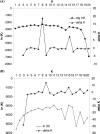Expansion of genetic diversity in randomly mating founder populations of Alternaria brassicicola infecting Cakile maritima in Australia
- PMID: 20097819
- PMCID: PMC2837991
- DOI: 10.1128/AEM.01594-09
Expansion of genetic diversity in randomly mating founder populations of Alternaria brassicicola infecting Cakile maritima in Australia
Abstract
Founder populations of fungal plant pathogens are expected to have low levels of genetic diversity coupled with further genetic drift due to, e.g., limited host availability, which should result in additional population bottlenecks. This study used microsatellite markers in the interaction between Cakile maritima and the fungal pathogen Alternaria brassicicola to explore genetic expectations associated with such situations. The host, C. maritima, was introduced into Australia approximately 100 years ago, but it is unknown whether the pathogen was already present in Australia, as it has a wide occurrence, or whether it was introduced to Australia on brassicaceous hosts. Eleven A. brassicicola populations were studied, and all showed moderate levels of gene and genotypic diversity. Chi-square tests of the frequencies of mating type alleles, a large number of genotypes, and linkage equilibrium among microsatellite loci all suggest A. brassicicola reproduces sexually. Significant genetic differentiation was found among populations, but there was no evidence for isolation by distance effects. Bayesian analyses identified eight clusters where the inferred clusters did not represent geographical populations but instead consisted of individuals admixed from all populations. Further analysis indicated that fungal populations were more likely to have experienced a recent population expansion than a population bottleneck. It is suggested that A. brassicicola has been introduced into Australia multiple times, potentially increasing the diversity and size of any A. brassicola populations already present there. Combined with its ability to reproduce sexually, such processes appear to have increased the evolutionary potential of the pathogen through recent population expansions.
Figures



Similar articles
-
Identification and characterization of microsatellite from Alternaria brassicicola to assess cross-species transferability and utility as a diagnostic marker.Mol Biotechnol. 2014 Nov;56(11):1049-59. doi: 10.1007/s12033-014-9784-7. Mol Biotechnol. 2014. PMID: 25048820
-
Genetic structure of populations of Alternaria brassicicola suggests the occurrence of sexual recombination.Mycol Res. 2005 Feb;109(Pt 2):227-36. doi: 10.1017/s0953756204001674. Mycol Res. 2005. PMID: 15839106
-
Metapopulation Structure Predicts Population Dynamics in the Cakile maritima-Alternaria brassicicola Host-Pathogen Interaction.Am Nat. 2021 Feb;197(2):E55-E71. doi: 10.1086/712248. Epub 2020 Dec 22. Am Nat. 2021. PMID: 33523787
-
Impact of the UPR on the virulence of the plant fungal pathogen A. brassicicola.Virulence. 2014 Feb 15;5(2):357-64. doi: 10.4161/viru.26772. Epub 2013 Oct 18. Virulence. 2014. PMID: 24189567 Free PMC article. Review.
-
How the necrotrophic fungus Alternaria brassicicola kills plant cells remains an enigma.Eukaryot Cell. 2015 Apr;14(4):335-44. doi: 10.1128/EC.00226-14. Epub 2015 Feb 13. Eukaryot Cell. 2015. PMID: 25681268 Free PMC article. Review.
Cited by
-
Genetic diversity and population structure of Alternaria species from tomato and potato in North Carolina and Wisconsin.Sci Rep. 2021 Aug 23;11(1):17024. doi: 10.1038/s41598-021-95486-6. Sci Rep. 2021. PMID: 34426589 Free PMC article.
-
Similar evolutionary potentials in an obligate ant parasite and its two host species.J Evol Biol. 2011 Apr;24(4):871-86. doi: 10.1111/j.1420-9101.2010.02223.x. Epub 2011 Feb 16. J Evol Biol. 2011. PMID: 21324025 Free PMC article.
-
The Population Genetics of Alternaria tenuissima in Four Regions of China as Determined by Microsatellite Markers Obtained by Transcriptome Sequencing.Front Microbiol. 2018 Dec 3;9:2904. doi: 10.3389/fmicb.2018.02904. eCollection 2018. Front Microbiol. 2018. PMID: 30559728 Free PMC article.
-
Identification and characterization of microsatellite from Alternaria brassicicola to assess cross-species transferability and utility as a diagnostic marker.Mol Biotechnol. 2014 Nov;56(11):1049-59. doi: 10.1007/s12033-014-9784-7. Mol Biotechnol. 2014. PMID: 25048820
-
Molecular diversity, haplotype distribution and genetic variation flow of Bipolaris sorokiniana fungus causing spot blotch disease in different wheat-growing zones.J Appl Genet. 2022 Dec;63(4):793-803. doi: 10.1007/s13353-022-00716-w. Epub 2022 Aug 5. J Appl Genet. 2022. PMID: 35931929
References
-
- Agapow, P. M., and A. Burt. 2001. Indices of multilocus linkage disequilibrium. Mol. Ecol. Notes 1:101-102.
-
- Anagnostakis, S. L. 1987. Chestnut blight: the classical problem of an introduced pathogen. Mycologia 79:23-37.
-
- Anderson, P. K., A. A. Cunningham, N. G. Patel, F. J. Morales, P. R. Epstein, and P. Daszak. 2004. Emerging infectious diseases of plants: pathogen pollution, climate change and agrotechnology drivers. Trends Ecol. Evol. 19:535-544. - PubMed
-
- Avenot, H., A. Dongo, N. Bataille-Simoneau, B. Iacomi-Vasilescu, B. Hamon, D. Peltier, and P. Simoneau. 2005. Isolation of 12 polymorphic microsatellite loci in the phytopathogenic fungus Alternaria brassicicola. Mol. Ecol. Notes 5:948-950.
-
- Banke, S., and B. A. McDonald. 2005. Migration patterns among global populations of the pathogenic fungus Mycosphaerella graminicola. Mol. Ecol. 14:1881-1896. - PubMed
MeSH terms
Substances
LinkOut - more resources
Full Text Sources

